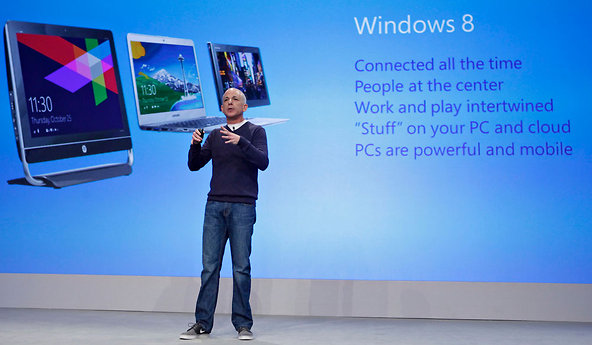 Microsoft Steven Sinofsky at the Windows 8 launch event last month.
Microsoft Steven Sinofsky at the Windows 8 launch event last month.
SEATTLE — Microsoft has unexpectedly parted ways with Steven Sinofsky, the leader of its lucrative Windows division and an executive often mentioned as a possible successor to the company’s current chief executive.
In a surprise announcement made late Monday evening, Microsoft said that Mr. Sinofsky, the president of its Windows division, would leave the company immediately after a 23-year career there. His departure was a mutual decision by Mr. Sinofsky and Steven A. Ballmer, Microsoft’s chief executive, according to a person briefed on the situation who was not authorized to speak on the matter.
His departure comes just weeks after Microsoft released Windows 8, the company’s biggest overhaul to its flagship software product in years. The move raises questions about how Microsoft, one of the giants in the technology business, will prepare itself for a new generation of leadership.
In an e-mail sent to all Microsoft employees Monday evening, Mr. Ballmer said the departure of Mr. Sinofsky, which he described as Mr. Sinofsky’s decision, comes at the start of a “new era” at Microsoft with the release of a wave of new products like Windows 8.
“I am grateful for the work that Steven has delivered in his time at our company,” Mr. Ballmer said in the e-mail. Frank Shaw, a Microsoft spokesman, said Mr. Sinofsky was not available for an interview. In a statement announcing his departure, Mr. Sinofsky, 47, said, “I am humbled by the professionalism and generosity of everyone I have had the good fortune to work with at this awesome company.”
Mr. Sinofsky was seen as one of the most competent managers within Microsoft and earned high marks for helping to improve the quality of its software after the company released Windows Vista, a widely criticized version of the operating system. A former technical assistant to Bill Gates, Microsoft’s co-founder, he was known to be a big admirer of Apple’s attention to detail in its products.
His name was often floated by people speculating about a possible successor to Mr. Ballmer, who has not announced any plans to retire from the company.
But Mr. Sinofsky was also a polarizing figure who alienated many other members of Microsoft’s senior leadership team. For that reason, he was viewed by many insiders as an unlikely replacement for Mr. Ballmer, one whose elevation to the top job would have created waves of dissent within the company.
By his detractors, Mr. Sinofsky was seen as territorial and often unwilling to cooperate with other divisions. In an internal review of his job performance last year, Mr. Sinofsky was faulted for failing to make sure that Microsoft lived up to a 2009 agreement with European regulators to offer users an easy way to install competitive Web browsers in Windows, according to a filing with securities regulators.
Mr. Sinofsky was also faulted for a 3 percent decline in the revenue of Microsoft’s Windows business, long one of its most profitable divisions and the foundation for its strength in the personal computing market. As a result of those failings, Mr. Sinofsky received 60 percent of the bonus he was to receive last year.
Windows 8, the product Mr. Sinofsky most recently oversaw, has received mixed reviews so far. The product has a drastically different look than previous versions, and Microsoft tailored the new operating system for use with tablets and other devices with touch-sensing screens.
Mr. Sinofsky also oversaw Microsoft’s decision to get into the computer hardware business with Surface, a tablet computer that has also earned mixed reviews.
Julie Larson-Green, another longtime Microsoft employee in its Windows division, will take over the leadership of all engineering responsibilities related to Windows. Tami Reller, the chief financial officer of the Windows division, will run business and marketing for the group.
Article source: http://bits.blogs.nytimes.com/2012/11/12/windows-chief-sinofsky-leaving-microsoft/?partner=rss&emc=rss